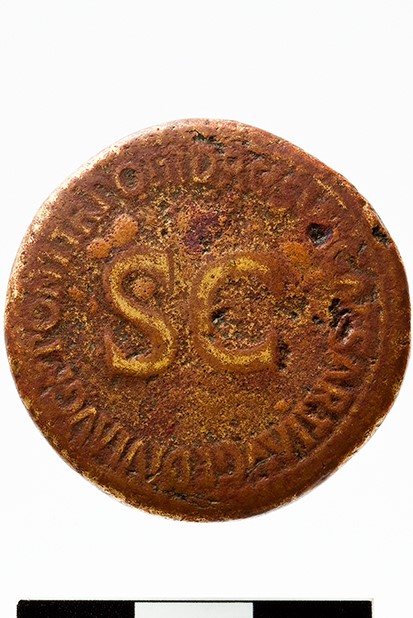Acquisition number: 1974.10
Obv.: Two crossed cornucopiae surmounted by heads of Drusus’ twin sons, with winged caduceus (herald's staff)between.
Rev.: DRVSVS CAESAR TI(berii) AVG(usti) F(ilius) DIVI AVG(usti) N(epos) PONT(ifex) TR(ibunicia) POT(estate) II. In centre, S(enatus) C(onsulto).
Title: Sestertius of Drusus, reign of Tiberius - 1974.10
Acquisition number: 1974.10
Author or editor: Beryl Rawson
Culture or period: Roman Imperial
Date: AD 23
Material: Metal - Brass
Object type: Coins - Roman
Dimensions: 33mm (w)
Origin region or location: Italy
Origin city: Rome
Display case or on loan: 5
Keywords: Coin, sestertius, Roman, Imperial, Drusus, Tiberius
Mattingly, H., E.A. Sydenham, C.H. Sutherland, R.A. Carson, The Roman Imperial Coinage 13 vols (London, Spink, 1923-1994) I 42; Sear, D.R., Roman Coins and their Values 5 vols (London, Spink, 2000-2014) 1793; Mattingly, H.,Coins of the Roman Empire in the British Museum, 6 vols (London, 1965) Tiberius 95; Giard, J.-P., Catalogue des Monnaies de l’Empire Romain 3 vols (Paris: Bibliothèque Nationale, 1988-1998) Tiberius 72, C1. [Rome, AD 23].
Rawson, B., ‘Representations of Roman children and childhood’, Antichthon 31 (1997), 74-95; Sutherland, C.H.V., Art in Coinage (London, Batsford, 1955) 84-85.
1974.10
Sestertius of Drusus, reign of Tiberius
24.279 g. AD 23
Obv.: Two crossed cornucopiae surmounted by heads of Drusus’ twin sons, with winged caduceus (herald's staff)between.
Rev.: DRVSVS CAESAR TI(berii) AVG(usti) F(ilius) DIVI AVG(usti) N(epos) PONT(ifex) TR(ibunicia) POT(estate) II. In centre, S(enatus) C(onsulto).
Drusus (the Younger) was the son of Tiberius and Vipsania (daughter of Agrippa), and adoptive grandson of Augustus: thus TI. AVG. F. and DIVI AVG. N. His titles reflect his position as Tiberius’ intended heir, and the obverse type celebrates the presence of twin sons in Drusus’ house to continue the succession another generation. Drusus, however, died later this year, as did one of the twins.
When Augustus had adopted Tiberius in AD 4 he required Tiberius to adopt Germanicus (Tiberius’ nephew), thus giving Tiberius two ‘sons’ and potential successors. But Germanicus died in AD 19, and Drusus’ position as the obvious single heir was strengthened by his joint consulship with Tiberius in AD 21 and his receipt of tribunician power in AD 22 (probably in the spring). See Tacitus Annals 3.56 on Tiberius’ request to the senate for tribunician power for Drusus. This coin, recording Drusus’ second year of tribunician power (TR. POT. II), must therefore date to AD 23.
Drusus had held a priesthood (thus ‘Pontifex’) from early in his career. Drusus was born c. 13 BC and the title is recorded in AD 7. Only the emperor was PontifexMaximus (high priest).
Twin sons were born to Drusus and Livilla late in AD 19. See Tacitus Annals 2.84 for Tiberius’ pleasure at this event. The obverse of this coin, issued about three and a half years later at a time when Drusus’ claims to the succession were being strengthened, underlines the blessings inherent in Drusus himself having heirs. The cornucopiae (horns of plenty) symbolise fertility and prosperity, and the caduceus (herald’s staff) was usually associated with trade and commercial prosperity (being a frequent attribute of Mercury, messenger of the gods and patron of merchants and travellers). See Sutherland (1955) on the ‘elegant formalism’ and ‘inner tenderness’ of this coin.
One of the twins (who had been named Germanicus) died in AD 23, and the other became known as Tiberius Gemellus (‘the twin’).
Drusus also died in AD 23 (September?), apparently poisoned by Sejanus and Livilla. (See Tacitus Annals 4.8ff.) Tiberius had to revise his succession plans several times thereafter, but when he died in AD 37 his will named Tiberius Gemellus co-heir with Gaius (Caligula). Gaius was seven years older and persuaded the senate to rescind Tiberius’ will. The senate recognised Gaius alone as emperor. Although Gaius adopted Gemellus as his own son and made him Princeps Iuuentutis (leader of youth), Gemellus was forced to suicide later in AD 37 or early 38.
Mattingly, H., E.A. Sydenham, C.H. Sutherland, R.A. Carson, The Roman Imperial Coinage 13 vols (London, Spink, 1923-1994) I 42; Sear, D.R., Roman Coins and their Values 5 vols (London, Spink, 2000-2014) 1793; Mattingly, H.,Coins of the Roman Empire in the British Museum, 6 vols (London, 1965) Tiberius 95; Giard, J.-P., Catalogue des Monnaies de l’Empire Romain 3 vols (Paris: Bibliothèque Nationale, 1988-1998) Tiberius 72, C1. [Rome, AD 23].
Rawson, B., ‘Representations of Roman children and childhood’, Antichthon 31 (1997), 74-95; Sutherland, C.H.V., Art in Coinage (London, Batsford, 1955) 84-85.

